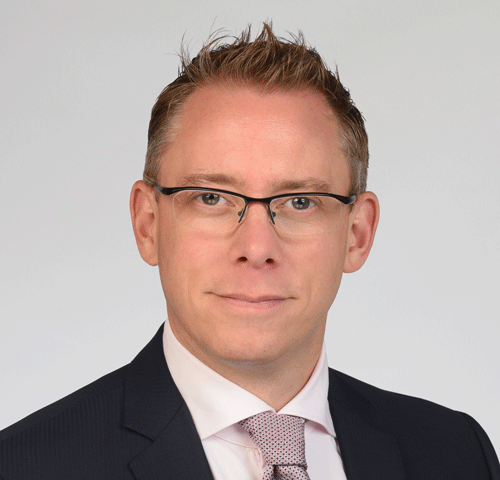THERE HAS BEEN A REGIME CHANGE IN FIXED-INCOME MARKETS, ACCORDING TO MICHAEL TRUDEAU AND FRÉDÉRIC BELHUMEUR AT MFS INVESTMENT MANAGEMENT.
The fixed-income landscape throughout the 2010s was characterized by easy monetary policy and low inflation that led to yield scarcity and subdued volatility for most of the decade. However, all of that changed in 2022. Elevated inflation and an aggressive monetary policy response created an environment of abundant yield, but it came at the cost of increased macroeconomic uncertainty and market volatility. With improved valuations, Trudeau and Belhumeur believe it’s time to reconsider fixed income through an active lens.

FRÉDÉRIC BELHUMEUR
DIRECTOR OF INSTITUTIONAL SALES,
MFS INVESTMENT MANAGEMENT

MICHAEL TRUDEAU
DIRECTOR AND INVESTMENT PRODUCT SPECIALIST,
MFS INVESTMENT MANAGEMENT
DID THE MARKET VOLATILITY OF 2022 CHANGE THE ROLE FIXED-INCOME INVESTMENTS PLAY IN A PORTFOLIO?
TRUDEAU: I wouldn’t say the role of fixed income changed, but I believe 2022 helped restore the traditional pillars and strategic appeal of the asset class, including its potential to deliver income, diversification and capital appreciation/ liquidity. We’ve also seen a substantial improvement in fixed-income valuations, increasing the asset class’s tactical appeal—and we think now is the time to consider bonds.
With the reset in yields last year, fixed income is offering attractive income again. Canadian government and corporate bond yields are at their highest levels in the last 10 to 15 years; and that’s critically important because, historically, the starting yield in fixed income has been a strong driver of subsequent returns. Buying at higher yields may provide investors with more of a yield buffer to absorb any further rate increases.
Higher yields have also increased the attractiveness of fixed income compared to equities, with government bond yields now greater than many equity dividend yields. As a result, fixed income now has the potential to offer more yield with historically less volatility than equities. This makes it an attractive de-risking option in an environment of elevated macroeconomic uncertainty.
With respect to diversification, there was an unusually high correlation between bond and equity returns in 2022 as both suffered large drawdowns. However, we’d argue that fixed income diversifies against economic downturns rather than equity returns. Last year, the Canadian economy was strong, but that is expected to change in 2023 as high inflation and interest rates impact growth and increase the prospects for recession. And with the Bank of Canada signalling we could be at the end of the tightening cycle, we seem to be at a turning point where fixed income can regain its diversifier status.
BELHUMEUR:
On liquidity, the past decade’s low yields pushed investors up the risk spectrum to achieve the yields they needed. Many moved from public fixed income to less transparent and less liquid private credit opportunities. However, as public fixed-income yields have now corrected to historically elevated levels, the case for private credit is weaker, as there is less need for investors to trade liquidity for yield.
For many years, investors feared duration. Now, they need duration to help them weather a potential economic downturn while collecting income at levels surpassing average dividend yields.
WHY IS IT MORE IMPORTANT THAN EVER TO TAKE AN ACTIVE APPROACH TO FIXED-INCOME INVESTING?
BELHUMEUR: Increased market volatility and macroeconomic uncertainty create more opportunity for active fixed-income managers to add long-term value. Fixed-income markets are cyclical and environments change. An active approach could be the difference between meeting goals or falling short. In this environment, fixed-income managers—especially those who engage in active sector allocation—can take advantage of valuation dislocations and dispersion through comprehensive fundamental research and rigorous security selection.
There’s also a difference in how listed securities get bigger on an equity benchmark versus a fixed-income benchmark. With an equity benchmark, it’s based on a corporation’s success. With a fixed-income benchmark, it’s based on how much issuers are willing borrow. So the dynamic isn’t as virtuous on the fixed-income side.
TRUDEAU: Our CEO, Michael Roberge, recently described this environment as a renaissance for active management. It’s true there’s an abundance of yield within fixed income today, but the opportunities must be approached carefully. Companies will now have to contend with higher debt-servicing costs in an environment of weakening growth. Yield is abundant, but not all yield is created equal; so having the capability and expertise to dig into fundamental credit research is likely to be critical in navigating this environment.
WHY IS MFS WELL POSITIONED TO ENTER THIS NEW INVESTMENT REGIME?
BELHUMEUR:
At MFS, we believe success in fixed income comes down to our people and our process. We have the research capabilities, experience and market presence, supported by 127* fixed-income professionals and resources to manage CAD $118 billion* in fixed-income assets under management. We also draw on the research of our equity team, engaging with companies on their vision, processes and ESG integration.
We have a local presence in Canada— and we’re also a global player. We have investment colleagues in Toronto, but also in eight other global locations, including Boston, London and Singapore. That’s essential because the challenges of inflation, supply chain disruption and volatility are not only Canadian issues—they’re global issues. Importantly, we have a long-term view, with a firm history approaching 100 years.
We use the strength and experience of our global research platform to pursue better outcomes for our clients by investing for the long term while seeking to exploit opportunities when markets are volatile. We’re in this together with our investors, and we believe our active fixed-income approach is key to navigating today’s challenging bond market and adding long-term value.
TRUDEAU:
We believe the best investment decisions take a holistic view, and our integrated global research platform, with more than 300 investment professionals across asset classes, allows us to do just that. As Fred alluded to, our equity and fixed-income research analysts across our investment platform are grouped into eight global-sector teams, allowing for ideas to be shared across regions, asset classes and capital structure. It also means we’re able to engage with companies more effectively on important sustainability issues. In this new regime, where we believe active management and fundamental research will be crucial to success, we feel this structure gives us an analysis advantage by having a 360-degree view of company fundamentals. This is particularly important within fixed income, where managing downside risk is crucial.
Finally, Fred mentioned our long-term focus. As a key pillar of our approach, it means that our analysts and portfolio managers are empowered to take a long-term view. That allows them to ignore the short-term noise that is ever-present in markets and make prudent long-term decisions that are in the best interests of our clients.
*As of 31-Dec-22
For institutional and investment professional use only.
Views expressed are subject to change at any time. These views should not be relied upon as investment advice, as securities recommendations, or as an indication of trading intent on behalf of any MFS investment product.
Michael Trudeau and Frédéric Belhumeur’s comments, opinions and analyses are for informational purposes only and should not be considered investment advice or a recommendation to invest in any security or to adopt any investment strategy. Comments, opinions and analyses are rendered as of the date given and may change without notice due to market conditions and other factors. This material is not intended as a complete analysis of every material fact regarding any market, industry, investment or strategy.
Distributed by MFS Investment Management Canada Limited. No securities commission or similar regulatory authority in Canada has reviewed this communication.
Unless otherwise indicated, logos and product and service names are trademarks of MFS and its affiliates and may be registered in certain countries.
Sponsored by:


